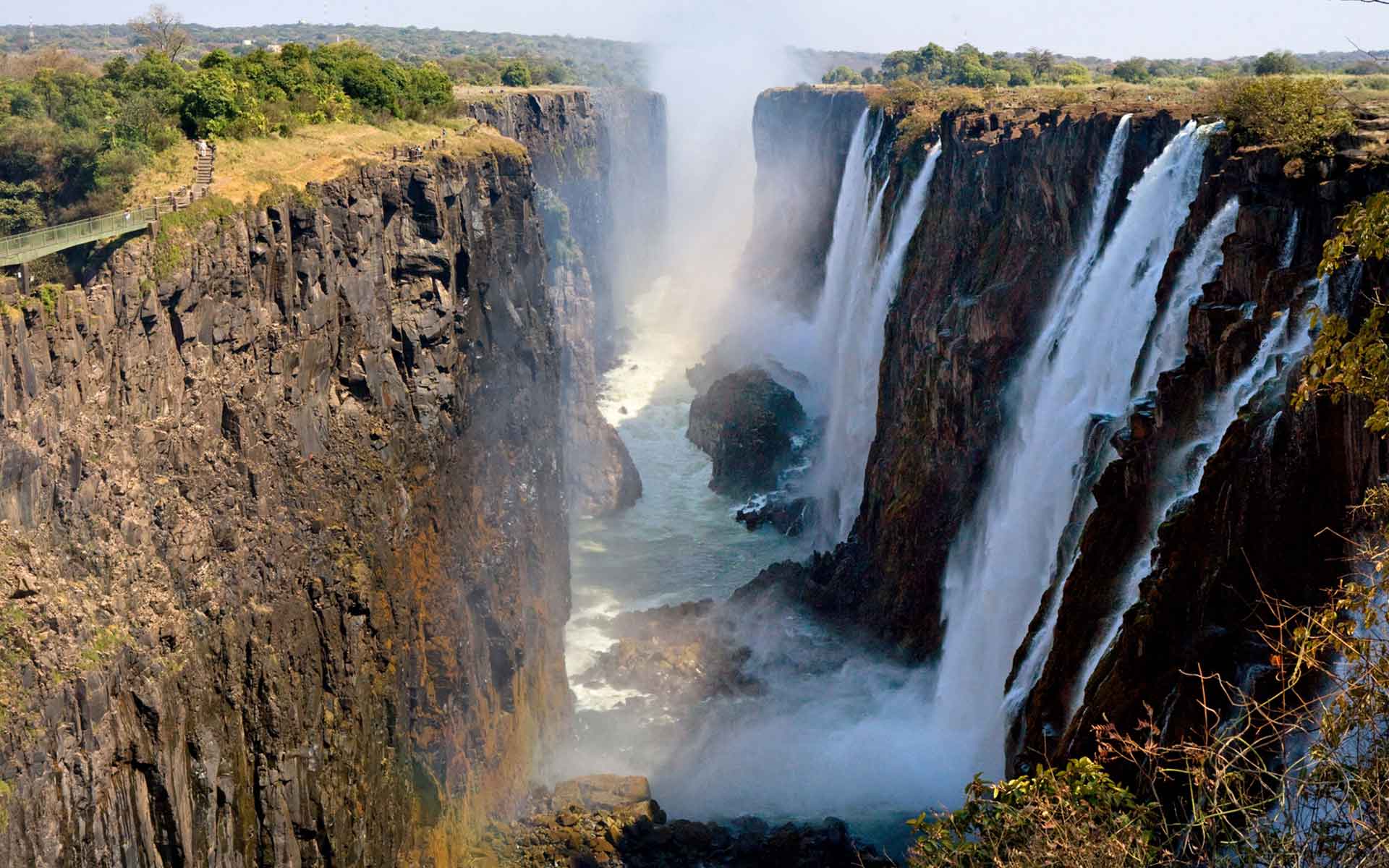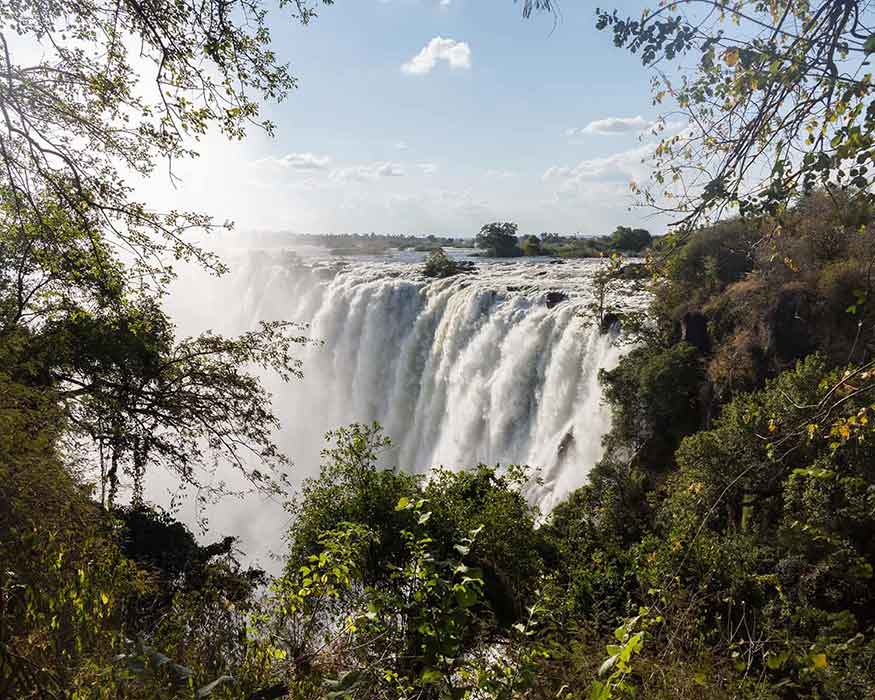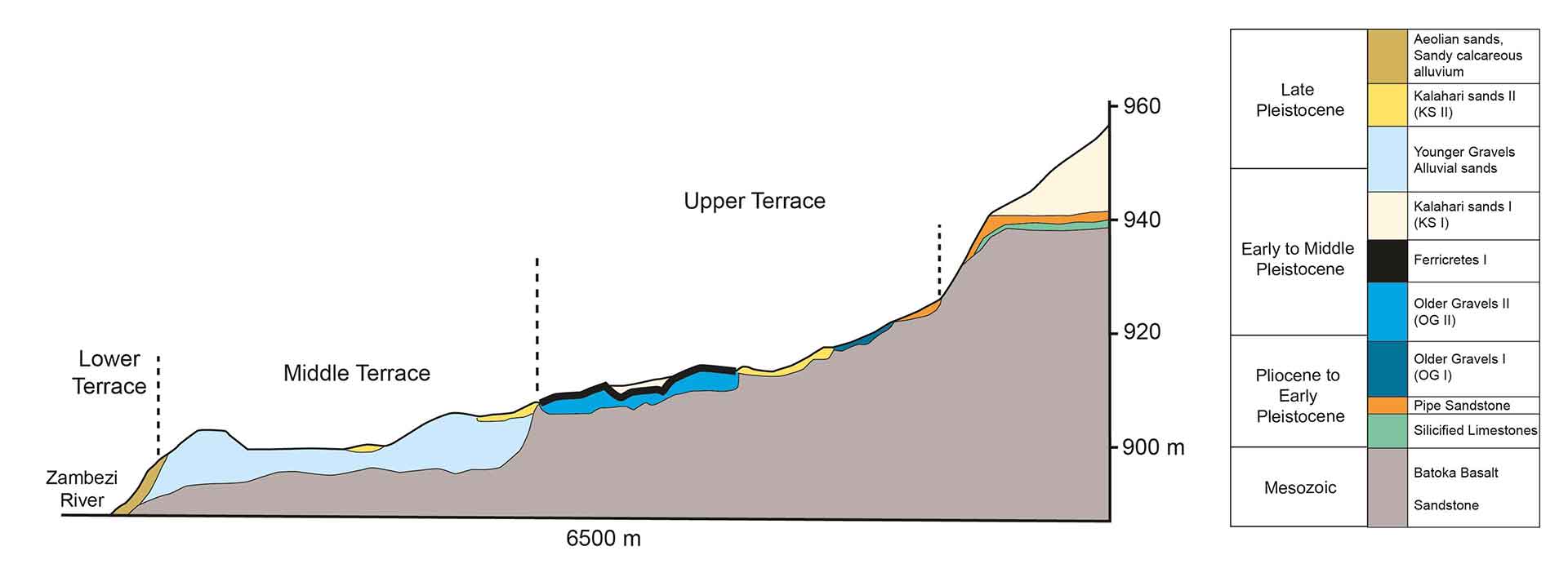
Clear evidence of the tectonic control in the norrowly incised gorges with basalt exposition.
Geological Period
Quaternary
Main geological interest
Geomorphology and active geological processes
Tectonics
Location
Zambia and Zimbabwe.
17°55’30.0″S, 25°51’30.0″E
Clear evidence of the tectonic control in the norrowly incised gorges with basalt exposition.
The “the smoke that thunders” forming the largest sheet of falling water in the world.
The Victoria Falls represent an outstanding example of the interplay between fluvial geomorphology, tectonics, and active erosive processes (active geomorphological and land formation processes). The Victoria Falls, Mosi-oa-Tunya [the smoke that thunders], has an outstanding beauty attributed to the falls, which raise an iridescent mist that can be seen more than 20 km away. The site exhibits erosive processes that cut back the basalt and thus caused migration of the Falls upstream.
- Geological description
The Victoria Falls are located on the Zambezi River, forming the boundary between Zambia and Zimbabwe. The Falls form the world’s largest sheet of falling water with a maximum vertical drop of 108 m, and a length of 1,700 m, in full flood (Moore and Cotterill, 2009). The Falls represent a major geomorphological break between low gradient of the up to 2km wide channel upstream and the steep gradient of the norrowly incised gorges downstream. The Falls are a culmination of a long geomorphological process initiated by diversion of drainage off the Kalahari plateau into the mid-Zambezi River that occupies a deep graben, and the Victoria Falls represent the modern position of a west-migrating knickpoint that incised the lower gorges into Jurassic layered basalts that form the bedrock (Derricourt, 1976; Lamplugh, 1907; Maufe, 1936; Nugent, 1990; Moore and Cotterill, 2009). The Victoria Falls and associated eight steep sided downstream gorges have been formed through the changing waterfall positions over an extended geological time. The gorges are an outstanding example of river capture in a tectonic basin. The erosive forces of the water continue to carve the hard basalt (UNESCO World Heritage Document, 1989). Evolution of the Falls and lower gorges was accompanied by deposition of late Cenozoic sediments of the Victoria Falls Formation, which preserve a remarkable assemblage of hominin artefacts.
- Scientific research and tradition
The Zambezi River including the Victoria Falls and the gorges and cataracts downstream have been a subject of geological, geomorphological and geographic research since the beginning of the 20th century, and hundreds of publications have been produced about it. Owing to the nature of the terrain more studies have been on fluvial geomorphology than the bedrock and the archaeological sediments deposited downstream. The Victoria Falls has also been used as an example for many high school geography students all around the world and featured in many textbooks.
- Reference
Derricourt, R.M. (1976) ‘Retrogression rate of the Victoria Falls and the Batoka Gorge’, Nature, 264(5581), pp. 23–25. Available at: https://doi.org/10.1038/264023a0.
Lamplugh, G.W. (1907) ‘The Geology of the Zambezi Basin around the Batoka Gorge (Rhodesia)’, Quarterly Journal of the Geological Society, 63(1–4), pp. 162–216. Available at: https://doi.org/10.1144/GSL.JGS.1907.063.01-04.14.
Maufe, H.B. (1936) ‘The Geology of the Victoria Falls’, The Journal of the Royal Anthropological Institute of Great Britain and Ireland, 66, pp. 348–368. Available at: https://doi.org/10.2307/2844085.
Moore, A. and Cotterill, F. (Woody) (2010) ‘Victoria Falls: Mosi-oa-Tunya – The Smoke That Thunders’, in P. Migon (ed.) Geomorphological Landscapes of the World. Dordrecht: Springer Netherlands, pp. 143–153. Available at: https://doi.org/10.1007/978-90-481-3055-9_15.
Nugent, C. (1990) ‘The Zambezi River: tectonism, climatic change and drainage evolution’, Palaeogeography, Palaeoclimatology, Palaeoecology, 78(1), pp. 55–69. Available at: https://doi.org/10.1016/0031-0182(90)90204-K.
UNESCO World Heritage Documents (1989) Mosi-oa-Tunya / Victoria Falls, UNESCO World Heritage Centre. Available at: https://whc.unesco.org/en/list/509/.
- Author(s)
Asfawossen Asrat
Botswana International University of Science and Technology, Palapye, Botswana


